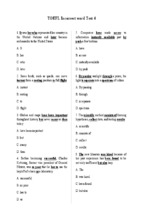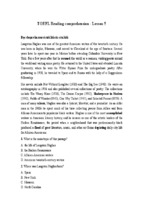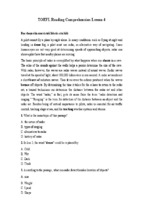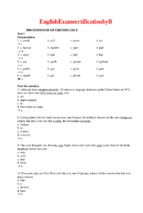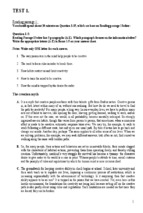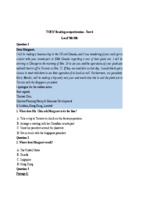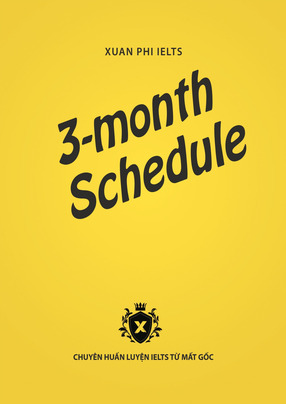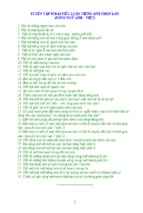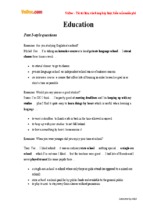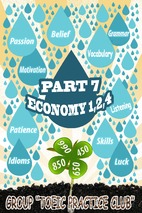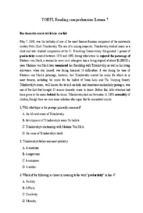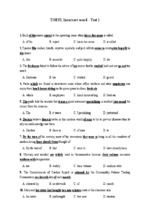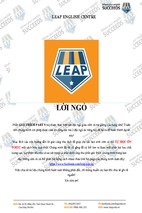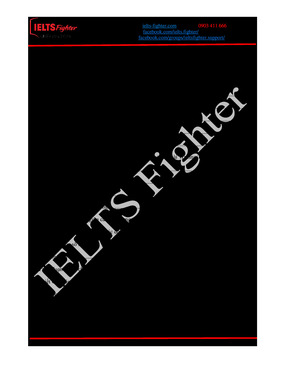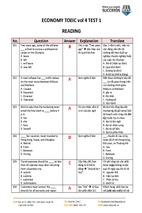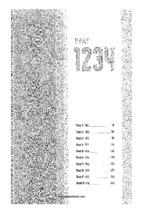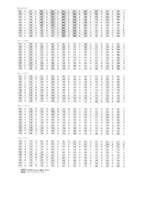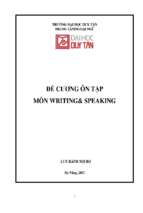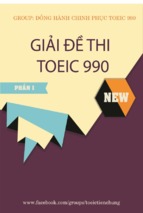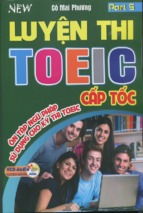TM*
•
• Advice from an experienced IELTS examiner
• Scripts for all Listening passages
• Model Speaking and Writing responses
McGraw-Hill Education
6
TM
Practice
Tests
McGraw-Hill Education
TM
Practice
Tests
Monica Sorrenson
New York I Chicago I San Francisco I Athens I London I Madrid
Mexico City I Milan I New Delhi I Singapore I Sydney I Toronto
Copyright© 2015 by McGraw-Hill Education. All rights reserved. Printed in the United States of
America. Except as permitted under the United States Copyright Act of 1976, no part of this publica
tion may be reproduced or distributed in any form or by any means, or stored in a database or retrieval
system, without the prior written permission of the publisher.
l 2 3 4 5 6 7 8 9 0
ISBN
MHID
RHR/RHR
l 2 1 0 9 8 7 6 5
978-0-07-184515-1
0-07-184515-1
e-ISBN 978-0-07-184517-5
e-MHID
0-07-184517-8
IELTS is a trademark of IELTS Partners, defined as the British Council, IELTS Australia Pty Ltd
(solely owned by IDP Education Pty Ltd), and the University of Cambridge: Cambridge English
Language Assessment. These organizations were not involved in the production of, and do not
endorse, this product.
McGraw-Hill Education books are available at special quantity discounts to use as premiums and
sales promotions or for use in corporate training programs. To contact a representative, please visit
the Contact Us pages at www.mhprofessional.com.
CONTENTS
Introduction . . . . . . . . . . . . . . . . . . . . . . . . . . . . . . . . . . . . . . . . . .vii
The IELTS Quiz . . . . . . . . . . . . . . . . . . . . . . . . . . . . . . . . . . . . . . . . 1
T he Listening Test and the Academic Reading Test ..................... 1
T he Academic Writing Test and the Speaking Test ...._.................. 4
What Do Strong Academic Writing and Speaking Candidates Do?........... 6
What Are Some Differences Between the IELTS Bands?.................. 7
Description of the IELTS Bands.................................... 8
Raw-Score Conversion Table for the Listening and Academic Reading Tests... 9
Listening and Reading Question Types . . . . . . . . . . . . . . . . . . 10
Question Types Used in the Listening Test Only....................... 10
Question Types Used in Both the Listening and Reading Tests ............ 10
Question Types Used in the Reading Test Only......................... 12
Glossary . � . . . . . . . . . . . . . . . . . . . . . . . . . . . . . . . . . . . . 15
Advice for the Listening Test . . . . . . . . . . . . . . . . . . . . . · . . . . . 18
Advice for the Academic Reading Test . . . . . . . . . . . . . . . . . . 20
Before You Do Test 1 . . . . . . . . . . . . . . . . . . . . . . . . . . . . . . . . . 22
Test 1 ...... . . . . . . . . . . . . . . . . . . . . . . . . . . . . . . . . . . . . . . . . . 23
Listening ................................................... 23
Reading ................................................... 33
Writing..................................................... 53
Speaking ................................................... 55
Answers .................................................... 57
Before You Do Test 2 . . . . . . . . . . . . . . . . . . . . . . . . . . . . . . . . . 68
Test 2 . . . . . . . . . . . . . . . . . . . . . . . . . . . . . . . . . . . . . . . . . . . . . . 69
Listening ................................................... 69
Reading ................................................... 81
Writing.................................................... 101
Speaking .................................................. 103
Answers . . . . . . . . . . . . . . . . . . . . . . . . . . . . . . . . . . . . . . . . . ;; . . . . . . . . 104
Test 3 ............................................. 115
Listening .................................................. 115
Reading .................................................. 121
Writing ................................................... 131
Speaking .................................................. 133
Answers . . . . . . . . . . . . . . . . . . . . . . . . . . . . . . . . . . . . . . . . . . . . . . . . . . 134
Test 4 ............................................. 143
Listening .................................................. 143
Reading .................................................. 149
Writing ..... .- ............................................. 159
Speaking .................................................. 161
Answers . . . . . . . . . . . . . . . . . . . . . . . . . . . . . . . . . . . . . . . . . . . . . . . . . . 162
V
Test 5 ............................................. 171
Listening.................................................. 171
Reading .................................................. 177
Writing ................................................... 187
Speaking.................................................. 189
Answers .................................................. 190
Test 6 ............................................ . 199
Listening............ : ..................................... 199
Reading .................................................. 205
Writing ................................................... 217
Speaking.................................................. 219
Answers .................................................. 220
Answer Sheets...................................... 229
Listening/ Reading Answer Sheets for Tests 1-6................. 229-240
To access the online audio tracks that accompany the tests
in this book, go to:
www.mhe1ELTS6practicetests.com
INTRODUCTION
Welcome to this book.
The number of people around the world who now take the IELTS exam is astounding. By work
ing through this book, you'll be closer to your IELTS goal and your post-lELTS dream.
McGraw-Hill Education 6 IELTS Practice Tests contains around 25 hours of material. Its six
practice tests develop exam technique, and its advice focuses on the Listening and the
Academic Reading tests. You'll do best in IELTS if you use this book together with other mate
rials, like McGraw-Hill Education IELTS, or with classes that improve your vocabulary, grammar,
spoken fluency, pronunciation, academic writing style, and knowledge of the world.
Like many things in life, attitude counts with IELTS. By that I don't mean preparing for a week,
then imagining that if you try your best, think positive thoughts, or compliment your Speaking
examiner, you'll receive a high score. I mean realistically assessing where you are now, in rela
tion to where you need to be, and putting in the effort to get there.
For those of you yet to sit IELTS, the exam is not easy, and the tests in this book are at the
level of real exams.
For those of you who've already sat IELTS, it takes months and even years to go up IELTS
bands. Teachers, tutors, classmates, people who comment on websites, friends, parents, loved
ones, and writers of books like this will all offer you advice, but the responsibility for your IELTS
score lies with you and you alone.
There are three parts to this book: (1) introduction (pp vii-21): This appraises your general
knowledge of IELTS with a Quiz (pp 1-9). It includes information on the four individual tests
and the nine band scores. It gives an overall impression of what makes a strong candidate
in speaking and writing (pp 6-8). It describes the different question types (pp 11-15) you'll
encounter, and has specific advice on the Listening and Reading tests (pp 18-21).
(2) Tests 1 and 2 (pp 22-114): are mainly printed on right-hand pages, while tips, called 'How
to get a Seven', are on the left. By following these tips, you'll be able to predict answers, find
cues or signposts, listen or look for paraphrases, understand inference, avoid common errors,
and, hopefully, get a Seven.
(3) Tests 3 to 6 (pp 115-227): have no tips. Questions for Tests 3 and 4 are at the level of
real IELTS exams,· but those for Tests 5 and 6 are slightly higher. This is to help people who
have already scored a Six aim for a Seven.
For easy access, answers to activities and tests appear throughout the book. Pay particular
attention to the ;nigliligfitea answers in the recording scripts and reading passages. Go through
all the writing and speaking models carefully, so you understand what examiners really expect.
vii
The IELIS Qui�
The Listening Test and the Academic Reading Test
What do you know about IELTS? For each question, circle the letter of your choice.
1
In total, how long is an IELTS exam?
a 2 hours 15 minutes
2
40
27/40
There is no maximum.
b
1 mark
C
It varies from test to test.
b
30/40
C
33/40
b
No. Reading is higher.
C
Yes
b
He or she loses one mark.
b
Five
b
Answers must come from the
recordings or the passages,
but candidates can change
them slightly, for example,
into plurals or participles.
C
He or she loses half a mark.
C
Three
C
Answers must come from the
recordings or the passages,
and they must not be
changed in any way.
C
Not so important. As long
as a person marking the
Listening answer sheet can
work out what the word is,
incorrect spelling doesn't
matter. In Reading, if a word
is copied wrongly, but is
recognisable, the mark is
given.
How important is spelling in the Listening or Reading test?
a Extremely important. To
b Very important. Usually, to
get a mark in Listening, an
get a mark in Listening,
answer must be correctly
an answer must be
correctly spelt, conforming
spelt, but if there's just one
letter wrong, then the mark
to standard UK, US, or
Australian spelling. In
is still awarded. In Reading, if
a word is copied wrongly, but
Reading, if a correct
is recognisable, the mark is
answer is copied wrongly, it
is marked wrong.
given.
10
100
Must all answers for a Listening or Reading test come from the recordings or passages, or can
candidates write down any answers they can think of that are correct?
a As long as answers are
right, it doesn't matter
where they come from.
9
C
What is the maximum number of words (or words and numbers) candidates can write for a Listening or
Reading answer?
a
8
50
In Listening or Reading, if a candidate doesn't answer a question, or writes a wrong answer, what
happens?
a He or she gets zero for
that question.
7
b
Is this the same for Reading?
a No. Reading is lower.
6
3 hours 15 minutes
Which mark approximately represents a band Seven in Listening?
a
5
C
How much is each question worth in the Listening or Reading test?
a ½ a mark
4
2 hours 45 minutes
How many questions are there in the Listening or Reading test?
a
3
b
When do candidates have an extra ten minutes to transfer their answers to answer sheets?
a
In Listening only
b
In Reading only
C
In both Listening and Reading
1
2
6 IELTS Practice Tests
11
What is the best use of the ten-minute transfer time at the end of the Listening test?
a Making sure most answers
are correct, and guessing
the others
12
13
a
17
18
19
20
21
Checking uncertain answers;
checking spelling; guessing
difficult questions
Nothing
b
A single example at the
beginning of Section 1
C
Each of the four sections
Yes
b
Mostly
C
No. They are all mixed up.
Should candidates write anything down while a person or people are speaking during a Listening
section, or should they wait until there is a pause?
Find correct answers as
you go, and circle or write
them down. Take notes
throughout, but especially
in Section 4. The pauses
should be used to read the
questions ahead. Use the
transfer time to go back
over uncertain answers.
b
Find correct answers as you
go, and circle or write them
down. Making notes is a
better idea than taking notes.
Then, check the answers
during the pauses. After all, a
narrator says, 'You now have
30 seconds to check your
answers.'
C
Concentrating without writing
anything down is a good idea.
You'll be able to remember
the answers, and do them
in the pauses. There are so
many pauses that you can
relax during some of them.
In which section of the Listening test do candidates below IELTS Six guess most answers or leave them
blank?
a
16
C
Do candidates hear the answers in the Listening test, or see them in the Reading test, in order, from
#1 to #40?
a
15
Making sure all answers
are correct, and leaving the
others
What is played twice in the Listening test?
a
14
b
2
b
3
C
4
In which section of the Listening test does one person give a short talk about an everyday situation?
a
1
b
2
C
3
In which section of the Listening test could there be three people talking?
a
1
b
2
C
3
C
A work one
What kind of environment would those three be in?
a A domestic one
b
An academic one
Which section of the Listening test has two people discussing a familiar transaction?
a
1
b
2
C
3
In which section of the Listening test is there no 30-second pause partway through?
a
2
b
3
C
4
When there are MCQs (Multi-Choice Questions: Options A, B, or C) in Listening, and there are twelve
. letters in total in a test's answers, what is the likely distribution of the letters?
a
It is entirely random.
b
The letters will usually be
evenly distributed: 4 As,
4 Bs, 4 Cs.
C
The letters will usually be
slightly unevenly distributed:
3 As, 4 Bs, 5 Cs; or 4 As,
5 Bs, 3 Cs etc.
The IELTS Quiz
22
Which factors make the Listening test difficult?
a
23
It has nine sets of
questions; it has around
20 word answers; the
topic of Section 4 may be
conceptually difficult.
b
It has speakers with all kinds
of accents; many of its word
answers are hard to spell;
Section 4 is very long.
C
Although it doesn't have
many word answers, its
MCQs have a lot of words in
their stems and options to
read; Section 3 has three
speakers; Section 4 is on a
scientific topic.
Excluding the questions, about how many words are there to read in the three passages of the
Reading test?
a
24
1700
b
2200
C
2700
Do the three Reading passages have a roughly equal number of words?
a
25
b
Yes
No. While Passage 3 almost
always has the most, Passage
1 or 2 could have the
second-most.
C
No. Passage 3 has more than
Passage 2; and, Passage 2
has more than Passage 1.
C
They are all the level of an
18-19-year-old student in an
English-speaking high school.
C
Because it has the most
questions
What level of difficulty are the Reading passages?
a
'
They range from the level
of an 18-19-year-old
student in an Englishspeaking high school to a
university graduate.*
b
They are all the level of a
first-year university student in
an English-speaking country.
26 . Why is Passage 3 usually harder than the other two?
a
27
Because It is the longest
b
Because the writer discusses
his or her views
To what extent is this sound advice? Read all the questions (stems and options) before answering
anything in the Reading test.
a
28
3
It is a good idea.
b
It is poor advice - there isn't
time. Read the passages
themselves first.
C
It is advisable to read all the
questions before starting
the reading passages, but, for
MCQs, only their stems not
their options - there won't
be time for these. Read the
options as you answer later.
C
Yes. The Reading test is
designed to trick certain
nationa Iities.
Is the Reading test more difficult for some nationalities?
>
a
No. It doesn't matter what
your background is, it is
still hard.
b
Yes. Reading is a
transferrable skill, so if
people in your culture rarely
read much that is long or
complex in any language,
you're going to struggle to get
a Seven.
*If you're interested in reading levels, look up 'Readability' or 'Flesch-Kincaid'.
4
6 IELTS Practice Tests
29
What strategies should candidates adopt in the Reading test?
a
30
Read the questions first so
you can identify where to
skim or scan in a passage,
or where to read slowly and
carefully; look for inference
as well as detail answers.
b
Read every single word as
fast as you can; the questions
are all about detail, so finding
where items are in a passage
is really important - most
answers rely on synonyms.
C
Do Passage 3 first because
it is the hardest; read
everything as fast as you
can; guess often because
you can still get a Seven by
guessing.
C
By doing as many IELTS
practice tests as possible.
How can candidates dramatically improve their Reading scores?
a
By reading academic
texts in English for about
30 minutes a day.
b
By reading in English as well
as in their own language for a
total of 60 minutes a day.
Answers: 1.b;2.a;3.b;4.b;5.c;6.a;7.c;8.c;9.a;10.a; 11.c;12. b; 13. b; 14.a;15.c;
16.b;17.c;18.b;19.a;20.c;21.c;22.a;23.c;24. b;25a;26.b;27.c;28.b;29.a;30.b
The Academic Writing Test and the Speaking Test
1
How many words must candidates write in the Writing test?
a
2
b
Task 2 is worth twice as much as Task 1.
Maps, plans, and diagrams are more
difficult.
b
Candidates may believe maps, plans,
and diagrams are more difficult, but they
are as difficult as charts and tables.
By including an overall statement; by
describing the main features (not all);
and, by including key data.
b
By noting all the features, and all the
data associated with them.
By outlining the process from start to
finish in one sentence (similar to the
overall statement above); describing the
key steps; and, using the passive voice.
b
By describing all the steps in the
process from start to finish; by
using the active voice and personal
pronouns, like 'you'.
How can candidates score a Six in Task 1 if it is two plans or two maps?
a
8
Both tasks are worth the same.
How can candidates score a Six in Task 1 if it is a diagram?
a
7
T hey lose marks.
How can candidates score a Six in Task 1 if the task is a chart or a table?
a
6
b
In Task 1, which is more difficult: charts and tables; or, maps, plans, and diagrams?
a
5
Nothing happens. Examiners are more
interested in quality than quantity.
What is each task worth?
a
4
b 2 50 in both tasks
What happens if candidates do not write enough words?
a
3
150 in Task 1; 250 in Task 2
By stating the major differences in
one sentence (similar to the overall
statement above), then describing
the key similarities and differences. It
is not necessary to describe them all.
b
By listing all the similarities and all the
differences.
Aside from lacking the vocabulary or grammar, why do many candidates not score a Six
in Task 2?
a
Their essay is long enough but simplistic. b
T heir essay is interesting but a little short.
The IELTS Quiz
9
Which better describes a Task 2 essay that is awarded a Seven?
a
10
The criteria vary from country to country
and IELTS centre to centre. The most
important things are that the essay
is long enough, and the grammar is
perfect.
No. It's equally difficult for everyone.
b
Yes. In some countries, the highschool and university education
systems do not encourage students
to write at length, and what is written
follows formulas. Moreover, if these
students do not read widely in their
own language or in English, they lack
sophisticated ideas necessary to get a
Seven. You can go to www.ielts.org for
a list of countries and languages to see
how different ones score.
Between 11-14 minutes
b
It must be 14 minutes.
Criteria vary from country to country
and IELTS centre to centre. The most
important things are that candidates
speak at length, and their grammar
and pronunciation are very good.
b
Criteria are: Fluency and Coherence;
Vocabulary Range and Accuracy;
Grammatical Range and Accuracy;
Pronunciation.
What is the basic difference in the Speaking test between Parts 1-2 and Part 3?
a
15
b
What criteria are used to mark the Speaking test?
a
14
The criteria are: Task Achievement;
Coherence and Cohesion; Vocabulary
Range and Accuracy; Grammatical
Range and Accuracy.
How long is a Speaking test?
a
13
A piece of writing that is academic in
style and pleasurable for an examiner
to read.
b
Do some nationalities do poorly in the Writing test?
a
12
A piece of writing that is highly
academic in style. It may not be so
pleasurable for an examiner to read.
What criteria are used to mark the Writing test?
a
11
5
Parts 1-2 deal with familiar
situations - things in and around a
candidate's own life. Part 3 deals
with abstract ideas - things beyond
a candidate's own life.
b
Parts 1-2 require short answers,
whereas in Part 3, a candidate needs
to speak at length. More complex
vocabulary is usually needed for Part 3.
Is it important for candidates to speak for the entire two minutes in Part 2? How many
words should a candidate·say?
a
Yes. These days, they have to speak
for two minutes, which is around
350 words.
b
It doesn't really matter if candidates
don't reach the two-minute mark.
Quality is more important than quantity.
. The number of words could be between
150-250.
.10> .
Do some nationalities do better in the. Speaking test?
a
No. It is equally difficult for everyone.
b Yes. In Part 3, some people lack
sophisticated ideas, and can only talk
about their own experience rather than
the world beyond.
There are other people for whom
English pronunciation is very difficult,
and these people may need private
tuition or to live in an English-speaking
country to improve.
Here are the answers for pp 4-6: 1. a; 2. b; 3. b; 4. b; 5. a; 6. a; 7. a;8. a;9. b;10. a;11. b;
12. a;13. b;14.a;15.a;16. b
What Do Strong Academic Writing and Speaking
Candidates Do?
Here are some adjectives to describe candidates or the answers they give in the Writing and
Speaking tests.
In the Writing test, what do examiners like?
Tick the positive attributes, and cross the negative ones as in the examples.
biased
bogus
edited
grammatically complex
elegant
exemplified
grammatically inaccurate
logical persuasive pertinent
rambling
succinct
formal
facile
legible
tangential
formulaic
lexically narrow
tempered under-length
What do the adjectives above mean?*
Complete each sentence on the left about a candidate with the best item on the right.
1 His writing is clear, logical, and well-supported. He uses less common
items of vocabulary, and his cohesion is unobtrusive. His writing is
A persuasive.
2 Her writing has appropriate vocabulary, much sourced from Latin. She B grammatically
complex.
avoids slang, personal pronouns, 'get', phrasal verbs, or texting. Her
language is
3
His sentences are varied, and include subordination. His word choices C succinct.
for number, tense, aspect, and voice are sophisticated. His writing is
4 Her arguments are convincing or believable. Her writing is
D tempered.
E
elegant.
6 Although she uses complex grammar, she does not include
F
edited.
5 His examples are completely relevant or
unnecessary words. Her vocabulary is so precise that she can use one
word where a lesser writer would use four or five. Her writing is
*An IELTS Seven knows many of these words; a Six knows five or six; and, a Five knows just two or three.
7
His arguments and examples are never extreme. They are moderate or G formal.
8 On her test paper, some words have been crossed out and replaced;
others have had minor changes made for spelling. Her writing is
H pertinent.
In the Speaking test, what do examiners like? Tick or cross again.
amenable
articulate
boastful
expansive
hesitant
idiomatic
opinionated
over-confident
coherent
contemplative
insincere
scruffy
memorised
courteous
natural
self-correcting
decontracted
obsequious
shallow
unruffled
What do the adjectives above mean?
Complete each sentence on the left about a candidate with the best item on the right.
1 She speaks clearly with fluent, sophisticated ideas. She's
A coherent.
2 He organises his ideas logically. He's
B idiomatic.
3 She gives thoughtful, considered answers. She's
C unruffled.
4 He's friendly, or he gives extended answers. He's
D self-correcting.
5 She uses phrasal verbs and less common items of vocabulary in
everyday speech. Her language is
E expansive.
6 He's relaxed, and he freely gives his genuine opinions. He's
F contemplative.
7 Although the questions become a little difficult, she doesn't show any G natural.
anxiety, and she answers as well as she can. She's
8 Aware of his mistakes, he reformulates his answers. He's
H articulate.
What Are Some Differences Between the IELTS Bands?
Many examiners can judge a writer or a speaker in one or two sentences.
Read the items, below, from Writing tests, and rank them from most to least competent: A-E.
There is an example.
The popularity of the fast food may be attributed to it's cost and convenience.
In a nutshell, peoples nowaday's love fast food because it is cheep and convinent.
In a nuts hell, pepol now a day liking the fast food. Is chip and convient.
C
It is well known around the world that fast food is getting more popular due to prize and
convenient.
Fast food is gaining popularity since it is cost-efficient and convenient.
8
6 IELTS Practice Tests
An A from above would probably score an Eight; a B a Seven; a C a Six; a D a Five; and, an
E a Four. (The order is: ADECB.) There isn't space here to explain why these bands would be
awarded, but you might like to compare the items, and discuss them with another candidate
or a teacher.
Read the utterances below from Speaking tests, and rank them from most to /east competent
(8-4), bearing in mind that you can't hear the candidates' pronunciation although some words
are written as they've been said. There is an example.
6
Yes, I would love to lorn more about photo-graphy. However, I will have to wait until my
children are at school. Furthermore, I think taking a course is a good ide-ea.
I'd like to learn more about photography, but, um, I'd have to wait till my kids were in the
school, and I'd need to take a course.
I'd like to learn more about taking photos, but I would have to wait until my children are
at school. And I think it is necessary for me to take the course.
Yes. I like to lorn to... to teck photo. But... but no time. Children at the home.
Yes, I love to learn new stuff. Why not the photography? But, um, my son, he's, like, at
home. When he's gonna school, then I learn the stuff.
Here are the answers for pp 6-8.
Adjectives to describe strong writing candidates: edited, elegant, exemplified, formal,
grammatically complex, legible, logical, persuasive, pertinent, succinct, tempered. Weak
ones: biased, bogus, facile, formulaic, grammatically inaccurate, lexically narrow, rambling,
tangential, under-length.
Sentence completion: Writing: 1. E; 2. G; 3. B; 4. A; 5. H; 6. C; 7. D; 8. F.
Adjectives to describe strong speaking candidates: amenable, articulate, coherent, con
templative, courteous, expansive, idiomatic, natural, self-correcting, unruffled. Weak ones:
boastful, decontracted (Eg: '/ am' instead of 'I'm'; 'it is' or 'it has' instead of 'it's'; 'they
will' instead of 'they'll' etc), hesitant, insincere, memorised, obsequious, opinionated, over
confident, scruffy, shallow.
Sentence completion: Speaking: 1. H; 2. A; 3. F; 4. E; 5. B; 6. G; 7. C. 8. D.
Speaking utterances: 687 45.
Description of the IELTS Bands
There are ten IELTS bands, and the creators of the IELTS exam describe them thus:
Band
Expert user
Has fully operational command of the language: appropriate, accurate
and fluent with complete understanding.
8
Ve,y good
user
Has fully operational command of the language with only occasional
unsystematic inaccuracies and inappropriacies. Misunderstandings
may occur in unfamiliar situations. Handles complex detailed
argumentation well.
7
Good user
Has operational command of the language, though with occasional
inaccuracies and misunderstandings in some situations. Generally
handles complex language well and understands detailed reasoning.
9
Competent
user
Has generally effective command of the language despite some
inaccuracies, inappropriacies and misunderstandings. Can use fairly
complex language, particularly in familiar situations.
Modest user Has partial command of the language, coping with overall meaning in
most situations, though is likely to make many mistakes. Should be
able to handle basic communication in own field.
Limited user Basic competence is limited to familiar situations. Has frequent
problems in understanding and expression. Is not able to use complex
language.
Extremely
Conveys and understands only general meaning in very familiar
limited user situations. Frequent breakdowns in communication occur.
Intermittent No real communication is possible except for the most basic
information using isolated words or short formulae in familiar
user
situations and to meet immediate needs. Has great difficulty
understanding spoken and written English.
Non user
. Essentially has no ability to use the language beyond possibly a few
isolated words.
Did not
No assessable information provided.*
attempt the
test
Go to www.ielts.org for more information on the bands, and on the public-access criteria exam
iners use to mark the Writing and Speaking tests.
Raw-Score Conversion Table for the Listening and
Academic Reading Tests
Here is a table of approximate marks out of 40 needed to achieve certain bands. Bear in mind
that the makers of the IELTS exam do not release this information, and that from time to time,
marks needed may be one higher or one lower, depending on the ease or difficulty of a real
IELTS Listening or Reading test.
Use this table to work out which bands you would score for the tests in this book.
37-38
*Printed by permission of Cambridge English Language Assessment. © UCLES 2015.
LISTENING AND READING
QUESTION TYPES
Question Types Used in the Listening Test Only
Multi-Choice Question (MCQ):
Choosing one answer from three options
Eg: What is the purpose of the lecture?
A
B
C
To get students to recycle smartphones
To let students know more about e-waste
To encourage students to develop an app
Eg: The lecturer talks about her family's behaviour because it is
A
B
C
typical.
exceptional.
ideal.
In the first example, the stem is a question; in the second, the stem is the first part of a sen
tence, which one option will complete, so the options end with full stops (periods).
Question Types Used in Both the Listening
and Reading Tests
THOSE WITH ANSWERS THAT ARE LETTERS: A-L
MCQ
Choosing two answers from five options
Eg: Choose TWO letters, A-E.
Which TWO of the following happen at Zoe's day care?
A
B
C
D
E
Parents must provide diapers and food for their children.
Children's birthdays are celebrated with songs and games.
Children are divided by age into rooms named after animals.
Parents who collect their children fifteen minutes late are fined.
The centre reserves the right to send home children who are ill.
11
Multi-Matching
Remember, in the Listening test, the information (11 and 12 below) goes in order of the
recording, but the options (in a box or a list) are almost always out of order.
Eg: Choose FOUR answers from the box, below, and write the correct letter, A-F, next to
questions 11-14 below.
A
Eliezer Montefiore
B
Grace Cossington-Smith
C
Paul Cezanne
D
Arthur Boyd
E
Wendy McEwen
F
A voluntary guide
11
He / She trains guides.
12
He / She was the gallery's first director.
In the Reading test, where there is a list (mostly of people), it almost always goes in order of
the information in the passage, but the questions are out of order. Be careful.
In questions where the answers are out of the recording or passage order, you'll notice in the
answers, after the correct letters, the phrase 'in any order' is written.
Labelling
There are three possible items to label - a diagram, a plan, or a map - by choosing an option
(A-?) from a list. See questions 26-28 in Test 6 Listening for an example. Labelling a plan or a
map is similar. See questions 17-20 in Test 5 Listening, or 17-20 in Test 3.
THOSE WITH ANSWERS THAT ARE WORDS OR NUMBERS
Gap-fill
There are several types of these, described in many books as: Sentence completion, Table
completion, Note completion, or Flowchart completion.
Essentially all types are the same. You must fill a gap, and write the word, words, number, or
word and number on your answer sheet. The maximum number of words to write is three.
Note: if you're asked: Write UP TO THREE WORDS for an answer, then make sure in that group
of answers, there's at least one three-word answer. Likewise, if you're asked: Write ONE WORD
AND/ OR NUMBER, then one answer will be a word+ a number. Where you have to fill gaps in
a table, note the direction of the answers: across or down. Mostly, they're across.
12
6 IE;LTS Practice Tests
Table completion
Eg: Complete the table below.
Write ONE WORD OR A NUMBER for each answer.
Teacher
Class
Sally Burton Working with
(5) ....................
Days
Location
Other information ·
In her studio
Number of students per
class: (6) ....................
Form completion
There's no difference between table and form completion, except the forms are similar to
ones from real life, so this type of question usually appears in Listening Section 1.
Note completion
There's no difference between table and note completion other than layout: notes tend to be
in one box, whereas tables have cells and columns within a box.
Sentence completion
Eg: Complete the sentences below.
Write NO MORE THAN THREE WORDS OR A NUMBER for each answer.
16
Since living in Mozambique, Charlotte has not used a fridge or a.................. .
17
Charlotte believes children who live in small houses tend to................... more.
Short-answer
Eg: Write NO MORE THAN THREE WORDS AND/OR A NUMBER for each answer.
15
What is the process of giving the same information about the same artworks?
16
How long is each guided tour?
Question Types Used in the Reading Test Only
THOSE WITH ANSWERS THAT ARE LETTERS: A-L
MCQ
Choosing one answer from four options
Eg: According to the writer, how much night lighting should there be in relation to what
there is now?
A
B
C
D
Much more
A little more
A little less
Much less
- Xem thêm -

